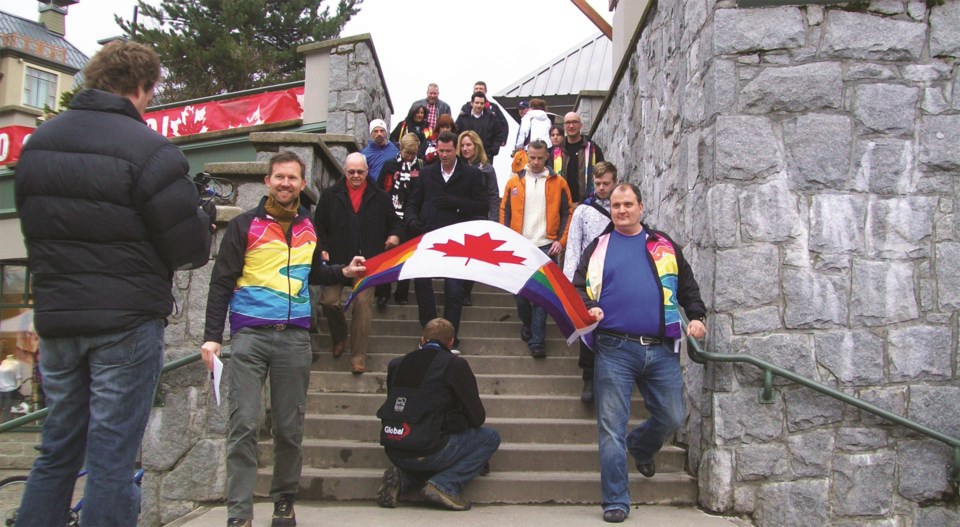Last week, the Whistler Museum opened our latest temporary exhibit, Pride & Progress: From the Grassroots Altitude to the Fearless Whistler Pride and Ski Festival, which looks back at the 30-year history of the Whistler Pride and Ski Festival. One of the most public and visible events of the festival is the Pride Ski + March, where skiers and snowboarders with rainbow flags make their way down Whistler Mountain towards Olympic Plaza. The first march through Whistler Village, however, took a shorter route and happened not during the festival but during the 2010 Olympic Winter Games. It was led by the first Pride House.
The idea of an LGBTQ2S+ space modelled on the hospitality houses set up by national Olympic committees took a few years to come together. While attending the 2007 InterPride conference in Zurich, Switzerland, WinterPRIDE (now the Whistler Pride and Ski Festival) organizer Dean Nelson was inspired while learning more about what pride meant in other countries, especially nations more hostile towards LGBTQ2S+ communities.
Three years later, with a lot of hard work, organization, and dedication, the first Pride Houses opened in February 2010, one in a portion of the Pan Pacific Whistler Village Centre and another in Vancouver (Pride House hosted a daily centre in QMUNITY, BC’s Queer, Trans, and Two-Spirit Resource Centre, while the sports bar Score on Davie served as a celebration space). In both locations, Pride House was designed to have multiple functions. They served as educational centres, with resources on many topics including homophobia in sport and Canadian immigration and refugee protection. They were also a welcoming space for LGBTQ2S+ athletes, coaches, officials, family, friends, and fans. Additionally, Whistler’s Pride House hosted a media room for unaccredited media, to which Nelson credits the high exposure of Pride House, as it offered a new Olympic story and a chance at more airtime. Over the 2010 Games, 5,000 people visited Whistler’s Pride House, including skeleton gold medallist Jon Montgomery and Olympic swimmer Mark Tweksbury.
Whistler Pride House’s march through the village came about in response to disparaging remarks made by two commentators about American figure skater Johnny Weir, in which they questioned his gender and the example he set for young skaters. Pride House contacted Whistler Media House (located in the Maury Young Arts Centre) to arrange a press conference with accredited media (Weir held his own press conference in Vancouver to respond to the remarks) and, quite literally, marched over with rainbow flags and banners.
Their march took them from the Pan Pacific Whistler Village Centre, down the stairs, along the Village Stroll, down to Celebration Plaza (today Olympic Plaza), around the Olympic Rings, and back to the theatre in what Nelson described as “probably the most dramatic press conference that the Whistler press team held during the Olympics and Paralympics.”
With a few changes to the route the following year, the march became part of WinterPRIDE. According to Nelson, “We’ve held onto that tradition ever since and I think it’s really important to have that visibility.” The festival has grown increasingly visible within Whistler over the past 30 years, from the Resort Municipality of Whistler raising rainbow banners in the village to businesses putting flags in their windows.
You can learn more about the growth of the Whistler Pride and Ski Festival and the legacy of Pride House at Pride & Progress, which will be on display at the Whistler Museum through April 19.





